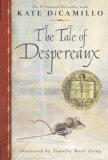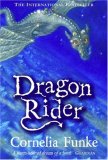Summary | Excerpt | Reviews | Beyond the book | Read-Alikes | Genres & Themes | Author Bio

Warriors: The New Prophecy #5
by Erin HunterThe increasingly popular Warrior series, based in the
forests of North America where four clans of feral cats fight to survive, launched in
2003 with Into The Wild. Four years later there are now 13 books in the
series with more in the works. This begs the
question, who is Erin Hunter, and how does she get to be so prolific? The
answer is a little complicated. According to the series website in 2006,
Erin Hunter was the pseudonym for two authors who take it in turns to write the
books. Revisit the website this year and it turns out that Erin Hunter is
now three people! When I asked someone at the publishing company where the
third author had appeared from I was told that the new author had always been a
key member of the team, responsible for keeping track of the plot lines, but had
come to the fore recently because she was the most comfortable doing author
tours.
Dig a little deeper and you'll find that there's even more people behind the
Warrior series because, like many successful children's series, the Warriors
series is created by a "book packager". Book packagers, also known
as book producers, are behind many of the "complex" books you'll see in
bookstores, such as coffee table books, pop-up books, heavily illustrated books
and how to books - in other words pretty much any book that requires a team of
people to create the initial concept.
Sometimes publishers hire a packager to develop a book they've originated,
sometimes book packagers pitch their own ideas to publishers.
Increasingly, book packagers are behind many of the most successful
children/teen series. One of the largest book packagers is
Alloy Entertainment
who describe themselves as "a creative think tank that develops and produces
original books, television series and feature films". Alloy are behind any
number of bestsellers such as The Sisterhood of the Traveling Pants series.
They're also responsible for a few projects they'd rather forget such as How
Opal Mehta Got Kissed, Got Wild, and Got a Life, which was withdrawn from
market last year following allegations of plagiarism (Boston
Globe article).
How can you tell if a book has been "packaged"? One way can sometimes be
to look at the copyright notice. For example, the copyright in the
Warriors series belongs to
Working Partners
Ltd.
Should you be concerned that a particular series is the product of a book
packager? On the whole, probably not. Firstly, because one could
argue that a good book is a good book however it was created; and secondly, the
chances are that some of your best loved childhood books were "packaged" and you
haven't suffered any lasting trauma as a result!
Although the term wasn't used then, Edward Stratemeyer (1862-1932) was arguably
the first book packager when he formed Stratemeyer Syndicates to create books
from his ideas. From this root came classic series such as The Bobbsey
Twins, Tom Swift, The Hardy Boys and Nancy Drew. Stratemeyer hired
ghostwriters who worked from his outlines, paying them a flat fee and publishing
under several pseudonyms. He established a policy, still used in many
projects today, that the writers were given no credit in the books and were not
allowed to speak about the books they'd written - thus maintaining the
illusion that each series was written by a single author.
Having said that, publishing a book under the authorship of a person who did not
originate the idea will feel wrong to many reading this, which is no doubt why
the book packaging industry does not go out of its way to publicize itself.
When one buys a book with an author's name on the front one tends to assume that
the author created the original manuscript that became the book, even while
recognizing that a team of people (agent, editor, proofreader, printer etc) were
involved in the transformation from manuscript to finished product.
However, in the case of a packaged book/series, it is more likely that the
original concept developed in a meeting room of marketing types and researchers
who, having ascertained a particular market niche to target, seek out a suitable
author/team of authors.
When we watch a movie we expect to see an exhaustive list of credits at the end.
Recognizing that no book is the work of a single individual, perhaps it is time
that the publishing industry started publishing a list of credits for each book
produced that acknowledges not just the role of the author, but also editor,
publisher etc - irrespective of whether the book was created in the traditional
sense or packaged!
![]() This review was originally published in The BookBrowse Review in September 2006, and has been updated for the
July 2007 edition.
Click here to go to this issue.
This review was originally published in The BookBrowse Review in September 2006, and has been updated for the
July 2007 edition.
Click here to go to this issue.

If you liked Twilight, try these:

by Kate DiCamillo, Timothy Ering
Published 2006
The beloved author of Because of Winn-Dixie enlightens us with a tale of adventure, despair, love, and soup. Ages 8+. Read the first 3 chapters exclusively at BookBrowse.

by Cornelia Funke
Published 2005
A dragon. A boy. A journey. Together, they embark on a magical journey to find the legendary place where silver dragons can live in peace for ever, with only a curious map and the whispered memories of an old dragon to guide them.
Your guide toexceptional books
BookBrowse seeks out and recommends the best in contemporary fiction and nonfiction—books that not only engage and entertain but also deepen our understanding of ourselves and the world around us.